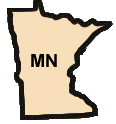How Does the Current Minnesota Unemployment Situation Compare to 1982?
Early signs show rate of jobs recovery in Minnesota moving at twice the rate of the recovery in the early 1980s

Many analysts say ‘yes’ – although during the past 3+ years in which the state’s jobless rate increased 121 percent from a trough of 3.8 percent in June 2006 to a peak (thus far) of 8.4 percent in June 2009, there were several periods of month-to-month drops in unemployment claims along the way.
From June 2006 through April 2007, unemployment rose or froze in each of these 11 months, rising 29 percent from 3.8 percent to 4.7 percent in Minnesota during this span.
Then, over the next year and a half, while the jobless rate slowly trickled up to 5.4 percent in September 2009, unemployment decreased on multiple occasions:
· Dropping from 4.7 to 4.6 percent in May 2007
· Declining from 4.6 to 4.5 percent in June 2007
· Decreasing from 4.7 to 4.6 percent in November 2007
· Falling from 5.4 to 5.3 percent in May 2008
It was just over one year ago when jobless claims really began to soar in the Gopher State (and nationwide). Over a nine-month period, from September 2008 to June 2009, unemployment increased 56 percent, from 5.4 percent to 8.4 percent.
If June 2009 truly ends up being the joblessness peak in Minnesota during this current economic downturn, the next million dollar question becomes: “When will unemployment return to its pre-recession levels of 2006?”
The most tempting basis for comparison is to look at how the economic recession and recovery unfolded in Minnesota during the 1980s.
Like in the current jobs crisis, the unemployment rate in the Gopher State started out in that recession at 3.8 percent, back in March 1979.
Then, over nearly a three year stretch to November 1982, the jobless rate rose and fell and rose again until eventually peaking at 9.0 percent – a bit higher than what Minnesotans have endured this year.
At that point, over the next five months as the jobs situation began to improve into the spring of 1983, unemployment fell by 5.5 percent in Minnesota, from 9.0 to 8.5 percent statewide. At this time the national rate was falling at about the same clip – from 10.8 percent to 10.2 percent during this five month stretch through April 1983.
During the current jobs crisis, unemployment has dropped more than twice this rate over the five months since its peak in June, at a rate of 11.9 percent, falling from 8.4 percent to 7.4 percent over this span. All the while, the national rate has actually increased 5 percent, from 9.5 to 10.0 percent.
In short, from a jobs perspective, Minnesota’s three-year downturn from 2006 to 2009 has, so far, not been as severe as the crisis faced from 1979 to 1982. And the jobs recovery is moving at a faster pace, despite comparatively greater sluggishness on the national scene.
That’s the good news.
However, even under the most optimistic scenarios, it is still likely to take years before the unemployment rate returns to the pre-recession level of 3.8 percent in Minnesota.
Back in the 1980s, it took exactly 12 years for unemployment to fall from its peak of 9.0 percent in 1982 back to its pre-recession level of 3.8 percent, finally reaching that level in November 1994.
Follow Smart Politics on Twitter.

The additional $65 million in losses occurred from January through March of 2008 and in January 2009, Giannoulias spokesman Scott Burnham said.
I’m often skeptical of unemployment rate numbers because they utilize so many different measurement methods and fudge factors. However, the improvements in Minnesota are also supported by the by the employment-to-population ratio which rose by a half of a percentage point in November up to 67.1 percent.
More jobs per capita is an encouraging sign.